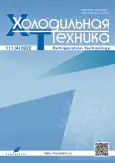Local low-temperature exposure: destruction, preservation, therapy
- Authors: Pushkarev A.V.1, Saakyan N.Y.1
-
Affiliations:
- Bauman Moscow State Technical University
- Issue: Vol 111, No 4 (2022)
- Pages: 273-277
- Section: Short Communications
- URL: https://bakhtiniada.ru/0023-124X/article/view/132751
- DOI: https://doi.org/10.17816/RF114720
- ID: 132751
Cite item
Abstract
The impact of local low-temperatures on biological tissues, depending on the temperature reached, can lead to destructive, preservation, or therapeutic effects. This paper takes a unified approach to the transition from general recommendations to personalized recommendations for the dosing of local low-temperature exposure. The exposure process is divided into three stages: planning, provision and control, and an analysis of compliance with the planned dose. Solutions to the problems of heat transfer in cryosurgery and cryopreservation are given to possibly improve the planning stage. In the framework of the first way, two cases are considered. The first case is to improve the accuracy of prostate cryoablation planning. The second case is to compare the effectiveness of various materials of cryosurgical applicators: copper, brass, and artificial sapphire, which can be used to influence and control the freezing zone by optical methods. In the framework of the second way, a case of using local low-temperature exposure to simultaneously preserve the framework of biological tissue and remove a layer of donor cells, called decellularization, is shown for transplantology. The results of the above examples can potentially be used to plan a local low-temperature impact. Thus, new-generation methods and technologies allowing accurate dosing can be developed.
Full Text
##article.viewOnOriginalSite##About the authors
Aleksandr V. Pushkarev
Bauman Moscow State Technical University
Author for correspondence.
Email: pushkarev@bmstu.ru
ORCID iD: 0000-0002-1737-7838
SPIN-code: 5796-8324
leading engineer, Cand. Sci. (Tech.)
Russian Federation, MoscowNatalia Yu. Saakyan
Bauman Moscow State Technical University
Email: natali.saakyan@mail.ru
ORCID iD: 0000-0001-6799-5450
SPIN-code: 4390-3138
student
Russian Federation, MoscowReferences
- Shurrab M, Wang H, Kubo N, et al. The cooling performance of a cryoprobe: Establishing guidelines for the safety margins in cryosurgery. International Journal of Refrigeration. 2016;67: 308–318. doi: 10.1016/j.ijrefrig.2016.03.007
- Rabin Y. Mathematical modeling of surface deformation during vitrification. Cryobiology. 2021;102:34–41. doi: 10.1016/j.cryobiol.2021.07.014
- Yamashita M, Miura H, Ohara Y, et al. Evaluation of Temperature Distribution Around the Probe in Cryoablation of Lipiodol-Mixed-Tissue Phantom. CardioVascular and Interventional Radiology. 2021;44(3):489–495. doi: 10.1007/s00270-020-02710-3
- Yoshikawa T, Miura H, Hirota T, et al. Fundamental Evaluation of Thermophysical Properties of Lipiodol Associated with Cryoablation: Freezing Experiments Using Lipiodol Phantom. CardioVascular and Interventional Radiology. 2020;43(3):514–519. doi: 10.1007/s00270-020-02710-3
- Ye J, Lugnani F, Yuan L, et al. The pattern of cell survival in the pig liver following one freeze-thaw cryosurgery cycle. Cryo letters. 2022;43(1):25–31. doi: 10.54680/fr22110110712
- Pushkarev AV, Ryabikin SS, Saakyan NY, et al. A study of prostate multiprobe cryoablation near urethra for precision treatment planning. Cryobiology. 2022;109:10–19. doi: 10.1016/j.cryobiol.2022.10.002
- Pushkarev AV, Ryabikin SS, Tsiganov DI, et al. Comparison of probe materials for tissue cryoablation: operational properties of metal and sapphire cryoprobes. Journal of Biomedical Photonics & Engineering. 2022;8(4):040501. doi: 10.18287/JBPE22.08.040501
Supplementary files







